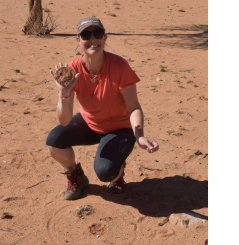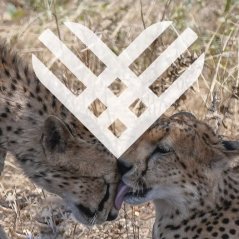News
Nature conservation sometimes takes a touristic detour
Volunteers travel to Namibia to work at cheetah conservation NGOs. On social media, cheetahs are portrayed in a ‘race against extinction.’ However, what is communicated on social media does not show the full picture of cheetah conservation in Namibia, researcher Suzanne Brandon argues in her dissertation.
On the cover of Suzanne Brandon's dissertation, a cheetah treats the reader to a piercing gaze through chicken wire. It is a characteristic image that stems from what she calls the 'Extinction Spectacle’. Over the past decade, the cheetah has risen to superstardom as an endangered species on Facebook and Twitter. This fame attracts volunteers to NGOs in Nambia whose questionable practices only seem to maintain the current situation for the species. Moreover, they take away attention from initiatives that could have a greater impact on the country’s biodiversity.

Brandon first encountered cheetahs when visiting Namibia for her MSc thesis on agriculture and food security. ‘Local farmers sometimes clashed with the cheetahs in the area. WUR gave me the opportunity to return to investigate this conflict,’ she explains. Brandon was supervised by David Ludwig and Professor Anita Hardon from the Knowledge, Technology, and Innovation chair group. For her research, she spent 13 months in Namibia collecting ethnographic data and two years collecting data online. She defended her dissertation on 21 February 2025.
#SaveTheCheetah
For her research, Brandon used a qualitative, embedded case study approach that included interviews, volunteer journals, observations, and literature study. This approach allowed her to explore what NGOs in Namibia actually do to protect cheetahs and how this fits within the country’s historical, social, and political context.
But in December 2016, an entirely new aspect of the topic emerged: the influence of social media. While spending Christmas with her family in the United States, Brandon noticed a surge of tweets and posts. Hashtags like #RaceAgainstExtinction and #SaveTheCheetah suddenly became popular. ‘I immediately realised: I need to include this in my research.’ So, she took screenshots and started collecting and analysing all the messages.
What had happened? A few scientists had recommended changing the cheetah’s conservation status worldwide from "vulnerable" to "endangered." Though the actual status remained unchanged, the news took on a life of its own. ‘Social media went into overdrive within just three days, with posts from all different sources, such as the BBC, National Geographic, the New York Times, as well as researchers, conservationists, the general public, and a few celebrities from across the world. This significantly amplified the alarmist message. Even now, on International Cheetah Day, we see spikes in online attention for the animal.’
The Extinction Spectacle
These three days of sudden attention aligned with a 2010 theory called ‘The Spectacle of Nature’, which describes how striking nature imagery is used to raise
awareness and engagement among the general public. However, Brandon observed an additional element in the case of the cheetah: the emotions stirred by the idea that a species might be lost forever—hence, the Extinction Spectacle. ‘I found that extinction was communicated through hashtags in social media posts,
allowing them to connect to larger audiences and garner more attention.’

The sudden focus on the endangered cheetah had consequences, Brandon found. ‘Information about the cheetah became fragmented, and misinformation was also spread. This claim paints an incomplete picture online of on-the-ground cheetah conservation in Namibia. The NGOs use the emotive nature of the term extinction to raise attention and money for their work.’ However, the real situation of the cheetah in Namibia is much more complex, Brandon says.
Threats from human-wildlife conflict
Cheetahs face global threats such as hunting and habitat loss. The Asiatic cheetah is listed as endangered on the Red List of Species. ‘However, my research in Namibia revealed that the cheetah population there was actually stable at the time I did fieldwork. They tend to avoid the well-protected national parks. That’s because lions dominate these parks as the apex predators, leaving no space for cheetahs. In fact, lions sometimes even prey on cheetahs.’
The spotted predator is more commonly found outside official nature reserves, a phenomenon linked to Namibia’s history, as detailed in the dissertation. Poor white livestock farmers from South Africa were given land in Central and Southern Namibia to farm during Apartheid. The presence of lions and other carnivores made livestock farming difficult, since lions were considered pests. Consequently, lions were exterminated in the area, which opened up a niche for cheetahs to fill. Brandon: ‘This is where human-wildlife conflicts arose, and they persist to this day.’
Volunteers in conservation
In Namibia, Brandon visited NGOs dedicated to cheetah conservation. These organisations are run by wealthy landowners, often also farmers. ‘These NGOs own large private estates and historically operate under minimal government regulation. They have the right to perform any activity within the parameters of Namibian law. As a result, the government has little oversight of their activities, which minimises their regulatory power.’
Interviews revealed that volunteers are highly engaged and motivated to contribute to cheetah conservation. They care for injured or rescued cheetahs, which live in enclosures often smaller than a football field. Volunteers feed the animals or conduct research. To participate, volunteers pay substantial fees. ‘Conservation has thus become a commercial enterprise. Volunteers are essential to funding NGO activities.’
This model has a clear downside, Brandon explains. ‘Cheetahs at the NGOs are rarely released into the wild. They cannot survive on their own, because they have not learned to hunt; they are contained in enclosures and fed by humans; specifically, volunteers. Releasing a cheetah that has spent more than three months in captivity poses a serious danger to the cat and to the people it could seek out for food.’
No contribution to biodiversity conservation
These practices makes cheetah conservation by the NGOs very different from conservation efforts by the Namibian government. ‘Conservation in Namibia conserves biodiversity as a whole in collaboration with local communities and works to provide economic benefits to these communities. Cheetah conservation by the NGOs is a business. It is unclear how their work contributes to biodiversity conservation in Namibia. In addition, the NGOs do not provide economic benefits to local communities.’
Brandon believes this phenomenon could be widespread in terms of NGOs or tourism operations that include captive species and international volunteering. ‘It is likely that conservation is a business elsewhere, too, but more research is needed in this area. Even large international conservation organisations do not adequately consider local issues of food security, poverty alleviation, and resource rights. I think that international conservation NGOs do not work in conservation unless their work directly supports communities with these issues.’
In Namibia, Brandon advocates for greater government oversight of volunteer programmes in wildlife conservation. In addition, she would advocate for greater oversight regarding claims to conservation by private actors, such as the cheetah conservation NGOs in Namibia. ‘When the emotive power of extinction is used to engage global audiences in local conservation crises and fund conservation NGOs, it creates a strong response. However, fear of losing a species is increasingly overriding narratives of social and ecological justice.’